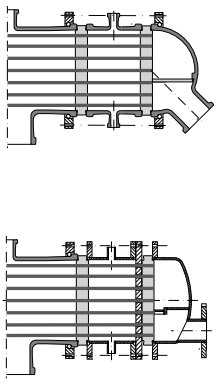Preventing Cross-Contamination in Shell and Tube Heat Exchangers
 Shell and tube heat exchangers, the most popular and widely used design, account for more than 50% of installations. They prove to be a multipurpose unit and a choice alternative to some of the other options such as coil-type or plate heat exchangers. Additionally, shell and tube models meet high-corrosion process needs effectively and allow for the widest range of allowable design pressures and temperatures. It can cope with the most stringent demands for product purity, process versatility and ease of maintenance.
Shell and tube heat exchangers, the most popular and widely used design, account for more than 50% of installations. They prove to be a multipurpose unit and a choice alternative to some of the other options such as coil-type or plate heat exchangers. Additionally, shell and tube models meet high-corrosion process needs effectively and allow for the widest range of allowable design pressures and temperatures. It can cope with the most stringent demands for product purity, process versatility and ease of maintenance.
There are, as with any piece of equipment, some disadvantages to consider. Thermal efficiency is somewhat lacking when compared to other types of heat exchangers. The unit is also subject to vibration caused by the flow of the thermal fluid and needs to be monitored to safeguard against failure. Another potential issue in a typical shell a tube heat exchanger design is the single tube sheet that separates the process and utility fluids. Any leak in the tube sealing (bushing, o-ring, weld, etc.) will cause immediate contamination of the side with the lower operating pressure. Sometimes it is possible to either live with the leak (using food grade heat transfer fluid in a cGMP situation) or prevent leaks by using a welded glass coil heat exchanger. If neither of these options is suitable, a double tube sheet design should be used.
Double Tube Sheets for High Purity and cGMP Applications
The double tube sheet design includes a glass safety chamber between the tube sheets. If any leaks occur, they will drain through the safety chamber instead of contaminating the other operating fluid. The glass safety chamber allows visual inspection of the tube sealing performance, allowing operations personnel to identify deteriorating seals and schedule maintenance during planned shutdowns. Fool proof prevention of cross-contamination not only gives you peace of mind but ensures high purity product and reduced product rework.
QVF shell and tube heat exchangers range in size from 2.5 to 25 m2 (27 to 270 ft2). As with other borosilicate glass shell and tube heat exchangers, a variety of materials can be used. Glass, Quartz, and Silicon Carbide tubes can be paired with glass, steel, or lined steel shells. Miscellaneous internals are made from PTFE. The exchangers can be designed as single or multi-pass.
For more information, see our SUPRA-Line catalog with additional technical information and available options.
